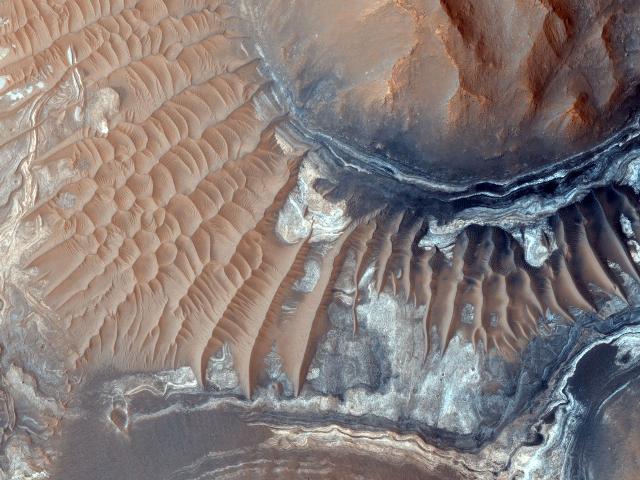Developers from the USA presented the concept of the Kozodoy spacecraft, capable of exploring the most interesting regions of the fourth planet, inaccessible to ordinary rovers and difficult to visit even if people land there.
The Labyrinth of Night Canyon system lies near the equator of Mars. Although there are flat areas, a significant part of the Maze is very rugged terrain, with steep cliffs, large boulders and fields of sand dunes. According to the artificial satellites of Mars, there are a lot of hydrated rocks on the slopes of the Labyrinth. Fog forms in this area in the morning, and clouds of water vapor form high above it in the afternoon. It is believed that there, in the deep shadows of the canyons, close to the surface there is a large volume of water ice.
But it's extremely difficult to explore all this. Existing rovers, even on flat terrain, move very slowly, by tens of meters per day or less. Sand dunes and especially cliffs with boulders are inaccessible to them: even when trying to force 10-centimeter sand, the rovers get stuck.
Another important factor is that the Maze of the Night is diverse and large. To study it, you will have to travel 300 kilometers. At the speeds of existing systems of this kind, it will take decades, despite the fact that so far rovers do not live that long.
Therefore, two groups of American scientists presented to the Scientific Conference on the Moon and Planets proposals for a mission of a fundamentally different type — a hexacopter planetship (that is, having six propellers). Although the idea was inspired by the success of the Ingenuity drone, the researchers separately stated that devices like Ingenuity would not be able to cope with such a task. A moderate number of propellers does not allow you to create enough lifting force to fly more than several hundred meters at a time on a single battery charge. Ingenuity has never even been able to climb to a height of more than 24 meters.

Part of the Labyrinth of the Night / © Wikimedia Commons
Therefore, the new spaceship will be made significantly larger and more massive, and six propellers will give it the necessary thrust without excessively long blades on each of them. If Ingenuity flew in the Jezero crater at atmospheric densities from 0.012 to 0.021 kilograms per cubic meter (depending on temperature), then in the Night Maze zone the density is lower — from 0.009 to 0.0145 kilograms per cubic meter. Only a really large hexacopter will be able to fly steadily in such conditions.
Unlike Ingenuity, the new Nighthawk ("Nightjar") will not be able to be based on a planetwalker, as it is unable to move in the Maze of the Night. So it will have to have deployable solar panels to replenish its energy reserves. To overcome high scree, the flight ceiling of the vehicle will be increased to 100 meters, four times.
There will be only three instruments on board: a visible-range camera, an infrared camera and a spectrometer, as well as a miniature neutron detector that can detect water and water ice under a shallow layer of sand (up to one meter). The Kozodoy will be able to fly close to outcrops on steep slopes and obtain rock spectra that it finds there. This opportunity is useful for studying the geological past of Mars. The total weight of the instrument load will reach three kilograms.
Due to the ability to fly, the device will cover 300 kilometers in a relatively short mission (less than a year). This is a record number: to date, not a single rover has been able to walk even 50 kilometers.
Along with the strengths of the concept, it is impossible not to mention its obvious bottlenecks. To deploy the solar panels at the top of the device after landing and then remove them again is a technically difficult task. So far, no one has tried to use such systems.
In addition, Mars is dusty, and dust makes it difficult for any folding mechanisms and devices to work. This is well known from the lunar experience, and the sad fate of many spacecraft that landed on the Red Planet and lost power due to the sand on solar panels.

